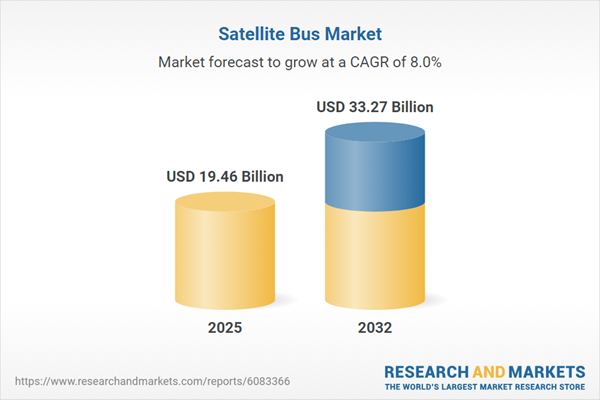Speak directly to the analyst to clarify any post sales queries you may have.
The satellite bus market is changing quickly as private investment, technological innovation, and international partnerships drive transformation across space systems integration and operations. Senior decision-makers must anticipate shifting regulations, supply chain disruptions, and evolving payload demands to capture growth opportunities and manage risk.
Market Snapshot: Strong Growth Trajectory in the Satellite Bus Market
The satellite bus market grew from USD 18.03 billion in 2024 to USD 19.46 billion in 2025. Propelled by a robust CAGR of 7.95%, it is forecast to reach USD 33.27 billion by 2032. This expansion reflects growing demand in telecommunications, earth observation, navigation services, and the evolution of modular bus technologies. Heightened investment across established and emerging space economies is fueling new program launches and reshaping platform requirements for both government and commercial initiatives.
Scope & Segmentation
- Orbit Type: Geostationary Orbit, Low Earth Orbit (including Lower Leo and Upper Leo), Medium Earth Orbit (with a focus on Navigation Orbit)
- Propulsion Type: Chemical Propulsion (Bipropellant Thruster, Monopropellant Thruster), Electric Propulsion (Arcjet Thruster, Hall Effect Thruster, Ion Thruster), and Hybrid Propulsion
- Payload Capacity: High, Medium, and Low
- Application: Communication (Broadband Internet, Satellite Broadcasting, Satellite Telecommunication), Earth Observation (Imaging, Remote Sensing), Navigation (Positioning, Timing), Science and Research (Astronomy, Microgravity Research)
- Regions Covered: Americas (United States, Canada, Mexico, Brazil, Argentina, Chile, Colombia, Peru), Europe, Middle East & Africa (United Kingdom, Germany, France, Russia, Italy, Spain, Netherlands, Sweden, Poland, Switzerland, United Arab Emirates, Saudi Arabia, Qatar, Turkey, Israel, South Africa, Nigeria, Egypt, Kenya), and Asia-Pacific (China, India, Japan, Australia, South Korea, Indonesia, Thailand, Malaysia, Singapore, Taiwan)
- Key Companies Profiled: Airbus Defence and Space SAS, Thales Alenia Space SAS, The Boeing Company, Lockheed Martin Corporation, Maxar Technologies Inc., Northrop Grumman Corporation, Mitsubishi Electric Corporation, OHB SE, Israel Aerospace Industries Ltd., RUAG Space AG
Key Takeaways for Senior Decision-Makers
- Industry trends indicate rapid adoption of modular and standard bus architectures, reducing development lead times and enabling flexible integration across diverse mission types.
- The shift toward constellation deployment in low and medium earth orbits is prompting manufacturers to develop scalable, cost-competitive platforms tailored for broadband, navigation, and science missions.
- Operators are leveraging digital engineering, real-time telemetry, and predictive maintenance to maximize bus performance and mission duration while minimizing long-term costs.
- Collaborative ventures between traditional prime contractors and emerging innovators are accelerating advancements in electric propulsion, advanced materials, and health monitoring subsystems.
- Growing regional investment and policy support in Asia-Pacific and EMEA are intensifying competition, encouraging technology transfers, and driving the need for regionally compliant manufacturing.
- Sustainability drivers and new digital twin use cases are elevating lifecycle management, supporting closed-loop supply chains, and supporting compliance with emerging environmental mandates.
Assessing Tariff Impact and Strategic Responses
Recent United States tariff measures have increased costs for core structural and electronic components. As a result, satellite bus integrators are diversifying suppliers, exploring material substitutions, and shifting some operations closer to end-user markets. Increased import duties on alloys and electronics have also spurred more agile procurement, accelerated alternate supplier qualification, and prompted manufacturers to renegotiate supplier agreements to protect production schedules and profit margins.
Methodology & Data Sources
This report is based on structured secondary research, proprietary data review, and direct interviews with satellite industry experts. It features input from satellite bus designers, propulsion specialists, and materials engineers while utilizing cross-referenced procurement records and public disclosures to ensure data reliability and transparency throughout the analysis.
Why This Report Matters for Decision-Makers
- Empowers organizations to tailor platform and manufacturing strategies for emerging market demands and regulatory complexities.
- Equips leaders to anticipate and address raw material volatility, supply chain disruptions, and new compliance requirements triggered by global policy shifts.
- Delivers actionable recommendations to improve supplier engagement, risk mitigation, and cost management for satellite bus programs.
Conclusion
The satellite bus industry is entering a phase defined by accelerated innovation, regulatory evolution, and regional opportunity. Informed strategic planning leveraging this analysis can help leaders drive sustainable market growth and operational resilience.
Table of Contents
3. Executive Summary
4. Market Overview
7. Cumulative Impact of Artificial Intelligence 2025
Companies Mentioned
The companies profiled in this Satellite Bus market report include:- Airbus Defence and Space SAS
- Thales Alenia Space SAS
- The Boeing Company
- Lockheed Martin Corporation
- Maxar Technologies Inc.
- Northrop Grumman Corporation
- Mitsubishi Electric Corporation
- OHB SE
- Israel Aerospace Industries Ltd.
- RUAG Space AG
Table Information
| Report Attribute | Details |
|---|---|
| No. of Pages | 183 |
| Published | November 2025 |
| Forecast Period | 2025 - 2032 |
| Estimated Market Value ( USD | $ 19.46 Billion |
| Forecasted Market Value ( USD | $ 33.27 Billion |
| Compound Annual Growth Rate | 7.9% |
| Regions Covered | Global |
| No. of Companies Mentioned | 11 |









